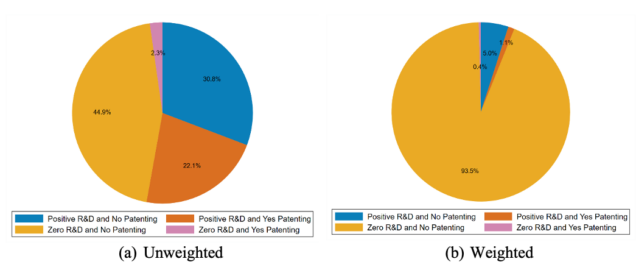Innovation and Appropriability: Revisiting the Role of Intellectual Property
By Filippo Mezzanotti and Timothy Simcoe
Economists generally view innovation as the most significant driver of long-run productivity growth. In their new working paper, Filippo Mezzanotti and Tim Simcoe study how firms capture the benefits of innovation using survey data collected by the US Census between 2008 and 2015. They use data come from the Business R&D and Innovation Survey (BRDIS), which aims to provide a representative picture of R&D activity conducted by for-profit, nonfarm businesses with five or more employees operating in the United States. Their paper is organized around five stylized facts.
Fact 1: Patenting is relatively uncommon in the economy, but most R&D is concentrated among patenting firms.
Patenting firms are relatively scarce within the US economy (see Figure 1). While less than 2% of all companies are patent, this group of accounts for over 90% of private US R&D investment.
Figure 1. Composition of Firms by Patenting Activities and R&D Spending
This pie charts report the (unweighted) share of firms in the data used split based on whether the firm is conducting R&D in the year of the survey and whether the firm is labelled as patenting firm, following the usual definition. In panel (a), we conduct this analysis without any adjustment from the raw BRDIS sample, while in panel (b) we incorporate sampling weights. The actual percentages per group are reported in the figure.

Fact 2: Patenting is not the main strategy to protect IP
Firms do not consider patents the most important tool for caturing the benefits of innovation. In the nationally representative sample, around 95% of firms report utility patents are not important, as shown in Figure 2. In relative terms, patents are consistently considered significantly less important than trade secrets, (and to a lesser extent) copyrights and trademarks.
Figure 2. Importance of Different IP Protection Strategies, All Firms
This bar graph reports the weighted share of response by firms to the question: During this past year, how important to your company were the following types of intellectual property protection? This example question is modeled on the 2008 version. We consider five types of protections: patents, trade secrets, copyrights, trademarks, and design patents.

Fact 3: The Importance of IP Varies with Product Market Characteristics
Figure 3 shows the importance of different types of IP protection across industries. Companies in the Life Sciences and the Information Technology sector consistently report that all forms of IP protection are more important. In general, however, the relative importance of different types of IP does not vary significantly by industry (except for the outsized importance of patents to Life Science and perhaps copyrights to IT firms).
Figure 3. Importance of Different IP Protection Strategies by Industry
This set of bar graphs reports the weighted share of response by firms to the question: During this past year, how important to your company were the following types of intellectual property protection? This example question is modeled on the 2008 version. We consider five types of protections: patents, trade secrets, copyrights, trademarks, and design patents. Each panel focuses on a different form of protection and reports the share of responses in each category by macro industry classification. In particular, we split the sample in Life Science, IT, Manufacturing, Retail, and others (residual category).

Fact 4: Importance of IP Does not Change as Firms Age
There is no systematic relationship between firm age and measures of IP usage. This result is robust to controlling for industry effects, firm size, R&D intensity, and other factors. One way to interpret this finding is that a firm’s IP policy might be modeled as a state variable that is determined at founding and remains constant over the life of the business. Consistent with this idea, they show that early decisions of a firm regarding R&D and patenting strongly predict future growth.
Fact 5: Larger firms are systematically more active in IP protection, across all forms of protection
In contrast to age, firm size is an important determinant of firms’ IP strategies. This relationship is monotonic and economically significant across all types of intellectual property (see Figure 4). This relationship between firm size and patenting is robust to controlling for other characteristics of the firm, including industry, age, R&D investment, innovation output, expertise in the market for technology, and the use of other types of IP.
Figure 4. Importance of Different IP Protection Strategies by Firm Size Group
This set of bar graphs reports the weighted share of response by firms to the question: During this past year, how important to your company were the following types of intellectual property protection? This example question is modeled on the 2008 version. We consider five types of protections: patents, trade secrets, copyrights, trademarks, and design patents. Each panel focuses on a different form of protection and reports the share of responses in each category by groups of firm size (using worldwide sales as proxy). The five groups are defined as followed: (0) 0-10 million; (1) 10-25 million; (2) 25-100 million; (3) 100-1000 million; (4) 1000+ million. All values are in US dollars nominal terms.

Conclusion
The stylized facts put forward by this study can be informative for both academics and policymakers who are interested in understanding the role of IP in explaining important recent trends in our economy. For instance, recent research has begun to investigate determinants of the economic advantages of large firms in developed economies. More broadly, this study contributes to the literature on the determinants of innovation activity, highlighting the importance of considering the heterogeneity across firms in IP strategies.